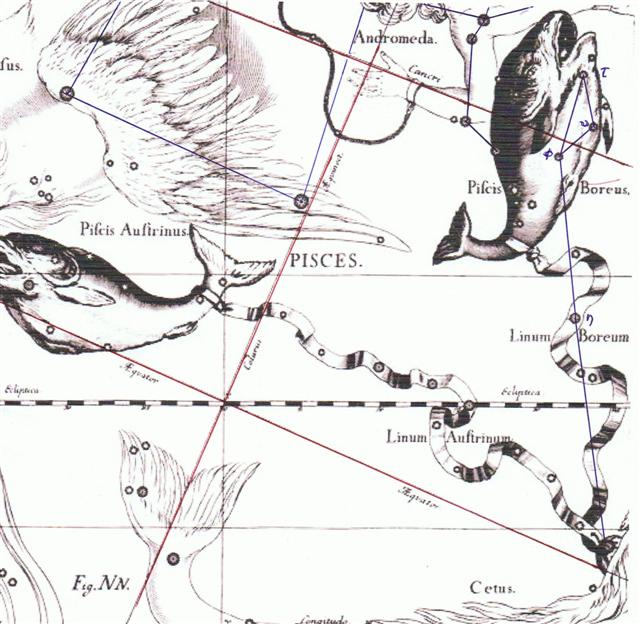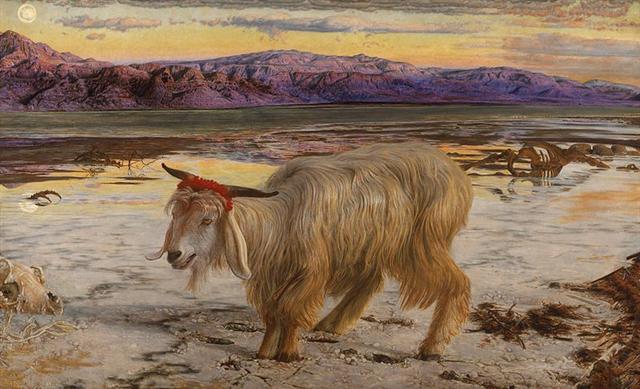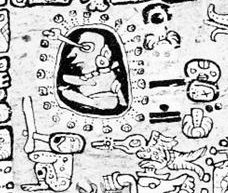Alrisha (α) is the knot at the end of Pisces, tying together the bands controlling the pair of winter Fishes. Alrisha is anchored to the neck of Cetus according to Hevelius:
Possibly the figures in winter (Sea) had to be securely anchored in order to remain where they should be. Also Andromeda was chained. Alrisha once ought to have indicated where at spring equinox the season of 'the Fishes' (winter) ended. Such a final was certainly much more important for people at that time than nowadays. Perhaps the age of a person initially was counted by how many winters he had survived. The fear of something negative is stronger that the force of something good. To get rid of the upleasant dark season when food gradually diminished would certainly have been one of the greatest times of the year. This could have been the motive of Metoro when he used the word oho - go away! To mind comes the scape-goat:
And when the bad star ruling winter went down in the southwest it was as if its 'eye' had been swallowed.
The eye is a most underful organ, capable of reaching out to the immense distances of the stars. This can hardly be possible unless there is a common denominator between a star and and the eye. One of the meanings of ika is victim:
Spring equinox can be regarded as the important point in time (tara) when 'Sea' disappears and 'Land' is finally reached, a happy landing after the dangers of winter. The beneficial gods had to be thanked and sacrifices were necessary: "Across the bows connecting each double canoe was a floor, covering the chambers containing idols, drums, trumpet shells, and other treasures for the gods and people of Ra'itea; and upon the floor were placed in a row sacrifices from abroad, which consisted of human victims brought for that purpose and just slain, and great fishes newly caught from fishing grounds of the neighboring islands. They were placed upon the floor, parallel with the canoe, alternatively a man and a cavalli fish, a man and a shark, a man and a turtle, and finally a man closed in the line. Behind this grim spectacle stood two or three priests in sacerdotal attire, which consisted of a plain loin girdle, a shoulder cape reaching down to the waist and tipped with fringe, wide or narrow according to their grades, and a circular cap fitting closely to the head - all made of finely braided purau bark bleached white. Seated at the paddles were the navigators and warrior chiefs in gay girdles and capes of tapa and helmets of various shapes, and wise men in plain girdles, capes, and turbans of brown or white tapa. As this terribly earnest procession arrived, the canoes were quietly drawn up along the shore, and the guests were met at the receiving marae by an imposing procession of the dignitaries and warriors of the land grandly attired, and also unarmed, headed by the king, the two primates, Paoa-uri and Paoa-tea, and the priests of the realm, who greeted them in low, solemn tones. Then everybody alike set to work silently disposing of the sacrifices just arrived, combined with others of the same mixed kind prepared by the inhabitants of the land. They strung them through the heads with sennit, and act called tu'i-aha, and then suspended them upon the boughs of the trees of the seaside and inwards, the fish diversifying the ghastly spectacle of the human bodies, a decoration called ra'a nu'u a 'Oro-mata-'oa (sacredness of the host of Warrior-of-long-face)." (Teuira Henry, Ancient Tahiti.) According to the C text these sacrifices perhaps could have happened on the central ceremonial ground (raaraa or marae) 3 days after Polaris had risen heliacally.
The stars which one after another marked spring equinox had to be changed because of the precession. But Polaris was not such a star, it would stand firm for a much longer time:
... Euclid said in his Phainomena: A star is visible between the Bears, not changing its place, but always revolving upon itself; Hipparchos, that the pole was 'in a vacant spot, forming a quadrangle with three other stars', both of these calling this Πόλος, the Polus of Lucan, Ovid, and other classical Latins; and Euphratean observers had called their pole-star Pūl, or Bīl. But, although other astronomical writers used these words for some individual star, there is no certainty as to which was intended, for it should be remembered that during many milleniums the polar point has gradually been approaching our pole-star, which 2000 years ago was far removed from it, - in Hipparchos' time 12º 24' according to his own statement qouted by Marinus of Tyre and cited by Ptolemy. Miss Clerke writes as to this: The entire millenium before the Christian era may count for an interregnum as regards Pole-stars. Alpha Draconis had ceased to exercise that office; Alruccabah [α Ursae Minoris] had not yet assumed it ...
Metoro's oho could maybe refer to the effects of precession on the old equinoctial (tara) stars. They had to be discarded, cast away, one after the other: '[Sahagun:] ... When it was evident that the years lay ready to burst into life, everyone took hold of them, so that once more would start forth - once again - another (period of) fifty-two years. Then (the two cycles) might proceed to reach one hundred and four years. It was called 'One Age' when twice they had made the round, when twice the times of binding the years had come together. Behold what was done when the years were bound - when was reached the time when they were to draw the new fire, when now its count was accomplished. First they put out fires everywhere in the country round. And the statues, hewn in either wood or stone, kept in each man's home and regarded as gods, were all cast into the water. Also (were) these (cast away) - the pestles and the (three) hearth stones (upon which the cooking pots rested); and everywhere there was much sweeping - there was sweeping very clear. Rubbish was thrown out; none lay in any of the houses.' (Anthony F. Aveni, Skywatchers.) To create a new cooking fire 3 'hearth stones' - probably corresponding to 3 stars (e.g. Alrisha, Alamak, and Hamal) - were needed.
| |||||||||||||||||||||||||||||||||||||||||||||||||||||||||









